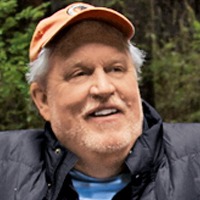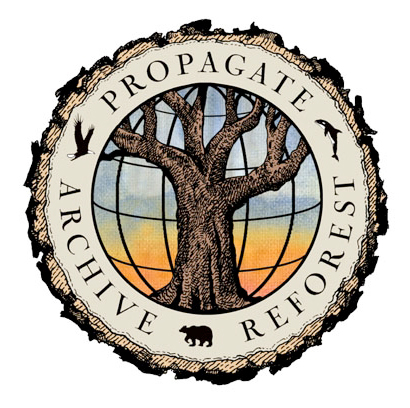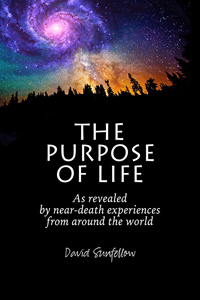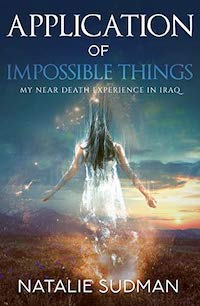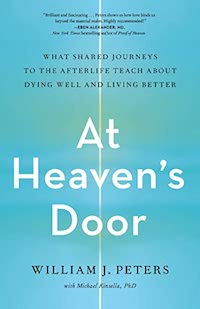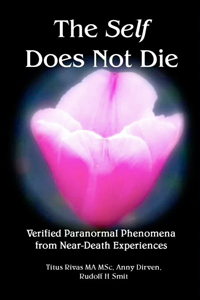![]()
David Milarch
Twenty years ago, David Milarch, a northern Michigan nurseryman with a penchant for hard living, had a near-death experience. After this experience, angels let him know that the earth was in trouble. Its trees were dying, and without them, human life was in jeopardy. The solution, they told him, was to clone the champion trees of the world — the largest, the hardiest, the ones that had survived millennia and were most resilient to climate change — and create a kind of Noah’s ark of tree genetics. Without knowing if the message had any basis in science, or why he’d been chosen for this task, Milarch began his mission of cloning the world’s great trees. Many scientists and tree experts told him it couldn’t be done, but, twenty years later, his team has successfully cloned some of the world’s oldest trees — among them giant redwoods and sequoias. They have also grown seedlings from the oldest tree in the world, the bristlecone pine Methuselah.
Websites & Background Information
• Archangel Ancient Tree Archive Website
• Archangel Ancient Tree Archive Blog
• Archangel Ancient Tree Archive on Facebook
Related Link
• How A Fictional Tree Planter Inspired Real Ones
Book
The Man Who Planted Trees: Lost Groves, Champion Trees, and an Urgent Plan to Save the Planet
Amazon Book Description:
“Twenty years ago, David Milarch, a northern Michigan nurseryman with a penchant for hard living, had a vision: angels came to tell him that the earth was in trouble. Its trees were dying, and without them, human life was in jeopardy. The solution, they told him, was to clone the champion trees of the world — the largest, the hardiest, the ones that had survived millennia and were most resilient to climate change — and create a kind of Noah’s ark of tree genetics. Without knowing if the message had any basis in science, or why he’d been chosen for this task, Milarch began his mission of cloning the world’s great trees. Many scientists and tree experts told him it couldn’t be done, but, twenty years later, his team has successfully cloned some of the world’s oldest trees — among them giant redwoods and sequoias. They have also grown seedlings from the oldest tree in the world, the bristlecone pine Methuselah.
“When New York Times journalist Jim Robbins came upon Milarch’s story, he was fascinated but had his doubts. Yet over several years, listening to Milarch and talking to scientists, he came to realize that there is so much we do not yet know about trees: how they die, how they communicate, the myriad crucial ways they filter water and air and otherwise support life on Earth. It became clear that as the planet changes, trees and forest are essential to assuring its survival.”
Recent News Stories
• A Savior Of Tree Species: Life’s Mission Inspired By Angel (09/07/13)
• Plan To Clone ‘Super-Trees’ Could Resurrect UK’s Ancient Forests (06/30/13)
• Non-Profit Cuts Douglas Firs To Prepare The Ground For Redwood Clones (12/18/12)
• World’s First Planting of a Champion Redwood & Sequoia Forest (11/28/12)
• Ancient Redwoods, Giant Sequoias To Be ‘Archived’ On Oregon Coast (11/26/12)
…………
…………
…………
…………
…………
For more information about this video, go here.
…………
A SAVIOR OF TREE SPECIES: LIFE’S MISSION INSPIRED BY ANGEL
By Francis X. Donnelly
The Detroit News
September 7, 2013
David Milarch believes he died and came back to life. And the reason was God had a mission for him.
The mission was simple if grandiose: Clone the biggest trees and cover the world with them.
The north Michigan nurseryman had little money, education or experience with cloning.
Few people had ever tried to reproduce such old trees, which scientists said was improbable.
Yet, in fits and starts, he has gradually cloned 140 species of trees across the United States, including ones that were 40 stories high and existed before Jesus was born.
Several thousand trees are growing at his research facility 25 miles southwest of Traverse City. He has planted 10,000 for free in northern Michigan and California.
His goal is to eventually plant enough trees to fight climate change. Trees absorb carbon dioxide, the greenhouse gas that contributes to global warming.
After nearly two decades of spreading the gospel, he gets calls from all over the world asking him to visit.
“Isn’t it about time we did something?” he asked. “Why is it so hard for people to understand that?”
Milarch, 64, has accomplished all this with charm, perseverance and a singular vision.
He is Johnny Appleseed in a trucker cap, a ruddy bear of a man trying to save the world.
Nothing can deter him from his quest, said his son, Jared.
“It’s an idea he cannot rest from,” the younger Milarch said. “It’s a testament to how focused he is on one issue. You can’t lose if you don’t quit.”
Milarch isn’t your typical environmentalist.
Unless, by “typical,” you mean a chain-smoking, profanity-spewing, hard-living farmer who once was an alcoholic and street brawler.
He says he gets messages from angels who guide his work.
The talkative Milarch tells you all this in a nonstop narrative about his life and work. He loves to tell stories that end with dramatic pronouncements.
“It’s all hands on deck,” he proclaimed. “The solutions are here. Mother Nature has the answers.”
One of the stories he tells is about the beginning of his crusade.
In 1991, he gave up drinking cold turkey but the sudden withdrawal caused kidney and liver failure.
Lying in bed, he felt his consciousness rise, leave the room and pass through brilliant white light. But an angel told him it wasn’t his time to die, that he still had work to do.
Several months later, still sober, he was awakened by bright lights in his bedroom. A female voice said she had an assignment for him.
The next morning he found a 10-page manifesto describing how to reforest the world. It was in his handwriting but he didn’t remember writing it.
His wife, Kerry, told him there was no way he had written it.
“There are no spelling mistakes,” she said, according to “The Man Who Planted Trees,” a 2012 book about his work.
At the time, Milarch wasn’t religious or a tree-hugger. He was just a third-generation tree nursery operator struggling to feed his family.
Spreading the growth
The gist of his plan is to clone champion trees, which are the tallest of their species, and spread them around the country.
He believes superior genes helped the trees grow so large and last so long. Through cross-pollination, the clones could spread their DNA to other trees.
Scientists said they don’t know whether genetics make some trees heartier than others. A bigger factor could be location, care or just luck.
But tree experts said they like Milarch’s idea of restocking the world’s forests.
Besides fighting climate change, trees help the environment by emitting oxygen, reducing runoff and absorbing toxic waste in the soil, they said.
Bill Libby, professor emeritus of forestry and genetics at the University of California, Berkeley, said Milarch is generating interest in trees and could develop breakthroughs in cloning.
“If you gather 100 such trees, it’s pretty likely that you have some trees that are better able to do that (become heartier because of superior genes).”
Financial difficulties
Milarch has been nothing if not resilient during his quixotic campaign.
Starting out in 1994, he borrowed a pickup, aluminum ladder and pruner from his dad. A bankruptcy had left him with no money.
In 2009, a black mold infected his tree warehouse, killing 16,000 cuttings in one month.
But his biggest challenge has been money. For 19 years, he has lurched from one source of funding to another. A grant here. A huge donation there.
In between are the hard times. In 2011, his nonprofit group, Archangel Ancient Tree Archive, and its 17-person staff closed up shop.
A donor allowed it to reopen last year with three workers but another crisis beckons in December when funding is due to run out.
“We’ve gone through financial hardships that would break most families,” Milarch said. “We’ve eaten a lot of potatoes.”
‘A walk of faith’
Despite the obstacles, he has painstakingly expanded his work from the state to the country to the world.
His constant proselytizing has drawn support from some scientists and well-heeled supporters, whose donations allow him to keep the enterprise afloat.
He turned an abandoned potato warehouse into a bustling facility where people clone, grow and ship trees.
He remains ever hopeful that somewhere, somehow, someone will step forward to allow Archangel to keep the lights on.
It’s the way of the group, he said.
“Every day of my life is a walk of faith,” he said. “I don’t know how this all is going to end up. But nobody will be able to say we didn’t give everything we could.”
…………
COMMANDED BY ANGELS TO PRESERVE THE EARTH’S CANOPY
By David Milarch
Guideposts
April, 2012
Death was near, my body shutting down. I lay limp in my bed at home, barely aware of my wife, Kerry, and my mother at my side. All I felt was sadness. And regret. What a waste. I was an alcoholic, too often an embarrassment to Kerry and our two sons, Jared and Jake. I didn’t want my kids to see me like this.
Too late, that summer of ’92, I’d tried to get sober — cold turkey, here in my bed. But my liver and kidneys couldn’t take the sudden withdrawal. I could barely breathe, my lungs filling with fluid. A friend took me to the emergency room, where they gave me a blood transfusion, but the doctor’s face was grim.
“We need to put you on dialysis,” the doctor said. “That will give you time to say good-bye to your family.” I’d come home a day ago. I was still alive. Barely.
Forty-one years. What had I accomplished? I was proud of the boys. Jared was 12 and Jake was 10, my helpers on our family tree farm. I’d tried to encourage them, told them to never give up on their dreams. But Kerry was really the one who’d seen to their upbringing.
The farm, 150 acres in northern Michigan, was my other passion. We grew shade trees: maples, locusts, birch. Did my life even matter?
Suddenly I felt a hard pulse in my chest, like a thud. I floated from the bed toward the ceiling. I looked down. My body lay in the bed lifeless. I looked awful, bloated, my skin yellow and gray. Like I’d washed up on a beach. Is this it? I thought. My time on earth over?
I felt a touch, gentle, yet firm, on my right arm. I turned to see a beautiful female in a radiant white gown. There was a fragrance, sweeter than any flower. I breathed it deep into my lungs. “We know you’re scared,” she said. “But we’re here to help.”
“Who are you?” I said.
“We’re here to help you,” she repeated. To my left there was another female, nearly identical to the first, holding my other arm. Angels? I wondered to myself. What could they want from me?
We left the confines of the house and entered a tunnel of light. The walls were a brilliant white, except for the glow of a thin pink and blue helix running through it. Then we shot off, like we were on the tip of a missile. It scared the starch out of me. But it was only for a few seconds.
I stepped out onto a vista. Below me a white, sandy beach leading to a vast body of water. In the distance a gleaming metropolis, lit by a prism of light, like a sunrise. I felt a comfort I’d never dreamed possible.
Love. Unconditional love. It seemed to flow all around me, like waves caressing me. My sadness, my sense of failure left me. I wanted to stay here forever.
Dozens of light beings, radiant, glowing personages walked toward me on top of the water. They didn’t have wings. They wore white gowns but the light, shimmering around each of them, was golden.
In the midst of them was another angel, a towering presence. He looked to be at least ten feet tall. He was clearly leading the others. Under a dark blue cape he wore a translucent gown of lighter blue.
I heard a booming sound, like thunder. It was the lead angel. “You can’t stay. You must go back.”
“But…” I started.
“You have work to do,” he said. Work? What kind of work? I didn’t want to leave. But before I could get another word out I was back hurtling through the white tunnel with the first two angels to my bedroom. I lowered back into my body, and then they were gone.
But what was the work I was supposed to do? “Wait! Wait!” I shouted, suddenly sitting upright.
“David, what’s wrong?” Kerry said, taking my hand.
It took a moment for me to know where I was. “It’s nothing,” I said. “But I know I’m going to get better. There were angels…”
Kerry squeezed my hand. “Don’t talk,” she said. “You’re so weak.”
Day by day, week by week, my body healed. It wasn’t easy. But every morning and night, I saw a small white glow near the ceiling. I lived for those moments, an assurance that God was still with me. What is the work he wants from me? I wondered. It made me nervous, not knowing. What if I can’t do it?
But there was no further instruction. By fall I was strong enough to get out of bed. One day, with halting steps, I went out to the porch and sat in a lawn chair. Everything seemed more alive than I remembered it, the chickadees, jays and finches singing so joyfully from their perches in the trees.
I could almost sense what they were feeling — there was gladness and celebration, an energy about them, but also an unease — something not right in their world. It was amazing, like I was getting a glimpse behind a magical curtain.
Could this be what God meant for me? To be more in tune with nature? I could do that. It was kind of nice actually.
But that wasn’t the only change. I had no interest in alcohol. I got misty-eyed just sitting outside with the birds, working next to our sons on the farm, eating one of Kerry’s home-cooked meals. I had a tenderness and compassion I’d never felt before. I couldn’t understand it. Why was this happening to me?
Then one winter night I awoke just after 1:00 a.m., surprised to find the bedroom lit by the warm glow that had given me such comfort. The light grew brighter and brighter until it was blinding. I covered my eyes with my hands, but it barely made a difference.
Kerry was sound asleep by my side. “Okay, I’m listening,” I said. “Just tell me what I need to do.”
A soft, warm female voice said, “Get a pad and pen and go to the living room.”
I rose out of bed, found a legal pad and a pen and sat nervously on the edge of my leather chair. But the voice was gone. My eyes grew heavy. I awoke with a start and looked at the clock. 5:55 a.m. But what about…I looked down at the pad in my lap. Page after page, filled with a detailed, formal outline.
I stared in wonder at the words: Dying trees. Champion species. Cloning. Reforesting. It was my handwriting, but nothing I’d ever even thought about. I had no memory of taking any of it down.
My heart raced as I read through what I’d written. The earth’s trees and forests getting sicker, weakened by pollution, drought, disease and bugs able to survive the warmer winters.
I was to clone the biggest, strongest, hardiest trees — trees that had lived hundreds, even thousands of years — so the world could one day be restored to its natural order by the giants of the forest. I felt like Noah, a simple man told to become a shipbuilder and a zookeeper and…
There had to have been a mistake. I wasn’t a scientist. I didn’t know the first thing about cloning or the environment. Where to even begin?
I needed help, a second opinion. I went to Jared’s room and shook him awake. “I need you to read this and tell me what you think,” I said.
Jared’s eyes opened wide as he read. “Dad, this is amazing,” he said.
“Can I help? We need to do this.”
“You really think we can?” I said.
“Why not?” he said. “You’re always saying nothing’s impossible.”
That summer, nearly a year after the angels first visited me, Jared and I collected our first DNA from a sugar maple, after learning the technique from researchers in Oregon. Seventeen years later my original outline became a reality.
It’s grown from my family and me into a nonprofit with nearly a dozen employees and volunteers, the Archangel Ancient Tree Archive.
We’ve taken DNA from more than 60 of the most magnificent trees on the planet, coast redwoods, giant sequoias, bristlecone pine thousands of years old, willow and yew—enough to create thousands of trees. We’ve been helped by angels—both heavenly and earthly— every step of the way.
We’re all called to help the earth. You don’t have to be a scientist. You only have to listen to the angel beside you.
…………
…………
…………
…………
…………
…………
…………
The Man Who Planted Trees: Lost Groves, Champion Trees, and an Urgent Plan to Save the Planet
By Jim Robbins
Twenty years ago, David Milarch, a northern Michigan nurseryman with a penchant for hard living, had a vision: angels came to tell him that the earth was in trouble. Its trees were dying, and without them, human life was in jeopardy. The solution, they told him, was to clone the champion trees of the world — the largest, the hardiest, the ones that had survived millennia and were most resilient to climate change — and create a kind of Noah’s ark of tree genetics. Without knowing if the message had any basis in science, or why he’d been chosen for this task, Milarch began his mission of cloning the world’s great trees. Many scientists and tree experts told him it couldn’t be done, but, twenty years later, his team has successfully cloned some of the world’s oldest trees — among them giant redwoods and sequoias. They have also grown seedlings from the oldest tree in the world, the bristlecone pine Methuselah.
When New York Times journalist Jim Robbins came upon Milarch’s story, he was fascinated but had his doubts. Yet over several years, listening to Milarch and talking to scientists, he came to realize that there is so much we do not yet know about trees: how they die, how they communicate, the myriad crucial ways they filter water and air and otherwise support life on Earth. It became clear that as the planet changes, trees and forest are essential to assuring its survival. The Man Who Planted Trees is both a fascinating investigation into the world of trees and the inspiring story of one man’s quest to help save the planet. This book’s hopeful message of what one man can accomplish against all odds is also a lesson about how each of us has the ability to make a difference.
Click here to order this book via Amazon
…………
An Interview with the Author
Q: How did you meet David Milarch, who is featured in this book?
In 2001 I wrote a story for the New York Times on Milarch’s plan to make copies, or clones, of some of the biggest trees in the country — the champions. By clones I mean he would take cuttings and root them, the way trees have been copied for centuries. That way, he reasoned, if one of the champions should die, its genetics would live on, since there would be hundreds of genetically identical copies planted in what he called living archival libraries. Not much is known about tree genetics, and so this was a way of preserving champion tree DNA until it could be studied. It was an intriguing idea.
Then, after the story came out, I met Milarch in person and he told me the idea to clone these big trees came to him after he had a Near-Death Experience — that is, he had died and returned to his body. I was shocked — I had never heard of such a thing. He told me that he was deeply inspired to clone the trees by spirit beings he met during and after his experience.
I didn’t know what to think of his story, but all of the scientists I spoke with about his plan to clone trees thought it was spot on, a smart idea.
Q: Why did you feel his was an important story to tell?
Scientists can’t say that trees are in trouble — there isn’t enough data. But privately they think that many trees and forests are in trouble and things will get worse as the climate warms, perhaps much worse. But Milarch can say trees are in trouble from his unique perspective. So his tale became an important and intriguing way to tell this story. And it’s all backed up with interviews with scientists.
Q: What happened to your own forest?
A few years after I met Milarch the entire 15 acre forest of trees around my house in Montana started dying, and some of the trees were 300 and 400 years old. And they kept dying until they nearly all disappeared, not only on my property, but across swaths of Montana, and across much of the Rocky Mountain West. And it’s far worse in Canada. The beetles that kill trees are thriving because it’s getting much warmer.
The ancient bristlecone pines, the oldest trees on the planet, are also dying. If the oldest, toughest trees on the planet, living on mountain tops in the West, are dying, I thought, no tree is safe. What happens in 10 or 20 or 30 years if it gets a few degrees warmer? Yikes!
It may happen even sooner. Look what’s happening to the weather this year — temperatures are warmer all over the US, and meteorologists say they haven’t seen anything like it.
Telling Milarch’s tale and the story of dying trees became even more urgent after I saw the forest die-off in the West, and in my own backyard.
Q: What is Milarch’s plan for these giants he is cloning?
He hopes someday that people will plant one clone of these champions in the midst of hundreds of other regular trees as a way of beefing up the genetics of forests.
Q: Why are trees important?
Milarch has often said that trees are more important than we know. And as I talked to scientists and read papers they confirmed that notion: we have underestimated the trees, vastly. They are a kind of eco-technology that sustains our lives here on the planet and that humans can’t duplicate. There is a whole range of ecosystem services provided by trees and forests that many people don’t know about. They filter our water and can clean up the nastiest kinds of toxic wastes. They soak up greenhouse gasses to mitigate climate change, protect us from harsh UV rays, and are a heat shield and natural air-conditioner for cities and suburbs. David Milarch talks about them as the filters of the planet. As we all know, when you take the filter out of your aquarium, the fish die.
Q: What can we do?
As Milarch says, trace back almost every environmental problem far enough and the solution is to plant trees. Trees are hope. But you can’t plant them just anywhere. It’s about strategically planting trees — the right tree in the right place for the right reasons. The big question we need to figure out is what is the right tree to plant and where.
…………
WHY TREES MATTER
By Jim Robbins
New York Times
April 11, 2012
Trees are on the front lines of our changing climate. And when the oldest trees in the world suddenly start dying, it’s time to pay attention.
North America’s ancient alpine bristlecone forests are falling victim to a voracious beetle and an Asian fungus. In Texas, a prolonged drought killed more than five million urban shade trees last year and an additional half-billion trees in parks and forests. In the Amazon, two severe droughts have killed billions more.
The common factor has been hotter, drier weather.
We have underestimated the importance of trees. They are not merely pleasant sources of shade but a potentially major answer to some of our most pressing environmental problems. We take them for granted, but they are a near miracle. In a bit of natural alchemy called photosynthesis, for example, trees turn one of the seemingly most insubstantial things of all — sunlight — into food for insects, wildlife and people, and use it to create shade, beauty and wood for fuel, furniture and homes.
For all of that, the unbroken forest that once covered much of the continent is now shot through with holes.
Humans have cut down the biggest and best trees and left the runts behind. What does that mean for the genetic fitness of our forests? No one knows for sure, for trees and forests are poorly understood on almost all levels. “It’s embarrassing how little we know,” one eminent redwood researcher told me.
What we do know, however, suggests that what trees do is essential though often not obvious. Decades ago, Katsuhiko Matsunaga, a marine chemist at Hokkaido University in Japan, discovered that when tree leaves decompose, they leach acids into the ocean that help fertilize plankton. When plankton thrive, so does the rest of the food chain. In a campaign called Forests Are Lovers of the Sea, fishermen have replanted forests along coasts and rivers to bring back fish and oyster stocks. And they have returned.
Trees are nature’s water filters, capable of cleaning up the most toxic wastes, including explosives, solvents and organic wastes, largely through a dense community of microbes around the tree’s roots that clean water in exchange for nutrients, a process known as phytoremediation. Tree leaves also filter air pollution. A 2008 study by researchers at Columbia University found that more trees in urban neighborhoods correlate with a lower incidence of asthma.
In Japan, researchers have long studied what they call “forest bathing.” A walk in the woods, they say, reduces the level of stress chemicals in the body and increases natural killer cells in the immune system, which fight tumors and viruses. Studies in inner cities show that anxiety, depression and even crime are lower in a landscaped environment.
Trees also release vast clouds of beneficial chemicals. On a large scale, some of these aerosols appear to help regulate the climate; others are anti-bacterial, anti-fungal and anti-viral. We need to learn much more about the role these chemicals play in nature. One of these substances, taxane, from the Pacific yew tree, has become a powerful treatment for breast and other cancers. Aspirin’s active ingredient comes from willows.
Trees are greatly underutilized as an eco-technology. “Working trees” could absorb some of the excess phosphorus and nitrogen that run off farm fields and help heal the dead zone in the Gulf of Mexico. In Africa, millions of acres of parched land have been reclaimed through strategic tree growth.
Trees are also the planet’s heat shield. They keep the concrete and asphalt of cities and suburbs 10 or more degrees cooler and protect our skin from the sun’s harsh UV rays. The Texas Department of Forestry has estimated that the die-off of shade trees will cost Texans hundreds of millions of dollars more for air-conditioning. Trees, of course, sequester carbon dioxide, a greenhouse gas that makes the planet warmer. A study by the Carnegie Institution for Science also found that water vapor from forests lowers ambient temperatures.
A big question is, which trees should we be planting? Ten years ago, I met a shade tree farmer named David Milarch, a co-founder of the Champion Tree Project who has been cloning some of the world’s oldest and largest trees to protect their genetics, from California redwoods to the oaks of Ireland. “These are the supertrees, and they have stood the test of time,” he says.
Science doesn’t know if these genes will be important on a warmer planet, but an old proverb seems apt. “When is the best time to plant a tree?” The answer: “Twenty years ago. The second-best time? Today.”
Jim Robbins is the author of the forthcoming book “The Man Who Planted Trees.”
…………
ANCIENT TREES HOLD HOPE FOR CLIMATE CHANGE
By Kim Eggleston
Second Wave
November 8, 2011
It’s not hard to see why David Milarch does what he does. Look around next time you drive through some of Michigan’s beautiful northern forests, and recall our state’s history.
The trees we see now are mostly the leftovers from centuries of cutting down the biggest and strongest to build homes, businesses and industries. Or, as Milarch calls them, “the junk of the junk” — what’s left after the best trees were taken, time after time.
For instance, the Upper Peninsula holds the only known stand of ancient white pines left in the world. The rest all have been harvested.
“What people don’t know is that we have geographic amnesia. We take a look around, see our forests, and think this is normal. It’s not,” he says.
Milarch, of Copemish, makes it his life’s work to study and clone genetic material from the largest, oldest trees still alive on the planet, like the giant sequoias of California, the ancient oaks of Ireland, or even the few remaining virgin white pine in Michigan.
Then, he and his colleagues at the Traverse-City based Archangel Ancient Tree Archive replant seedlings grown from the cloned material, along with other seedlings of the same species but from newer genetic stock, to get the best of both worlds as the old and new genes propagate together.
“We’re finding the very largest living trees and archiving their genetics,” he says. “Not the genetics of the very junk of the junk.”
And his ideas have drawn quite a bit of attention as climate change becomes an urgent problem for the world, because of a simple fact: Giant trees like the redwoods are much better at filtering and storing carbon than most modern trees are. A sequoia is about 40 percent carbon, captured from the atmosphere, says Milarch, and 40 percent of a giant sequoia is a pretty large amount.
So, replanting lost forests with ancient trees like those in the archive is a more effective method for slowing or moderating climate change than simply replanting any tree available.
To that end, Milarch is working with NASA scientists to determine what kind of role his giant sequoia seedlings could play in strategic carbon sequestering. They are particularly suited for the job as opposed to other ancient trees, because they are hardy and adaptable enough to grow in climates from sub-Arctic to sub-tropical. Other trees are more suited to other purposes, like black willow, which is good at remediating watersheds, he says.
Archangel has collected genetic material from the biggest and oldest trees still alive in many regions of the U.S., and recently added samples from the 20 oldest oaks in Ireland to its collection. The archive now holds about 70 species of trees.
All the seedlings are grown in Copemish, in an old, converted warehouse that now serves Archangel as a propagation facility to nurse the cloned seedlings to plantable age.
Milarch works there with his two sons, who are raising their own children on the family’s land there — the sixth generation in Copemish.
The location reveals the roots of the idea for all this; Milarch began as a tree farmer, working in his family’s seed tree company.
“The trees that used to work (producing seedlings), and had worked forever, stopped working. They would die, right down the row,” he says. “Well, when what you make your living on doesn’t work anymore, you better find out why.”
The answers he found were grim: acid rain, water pollution, invasive species, resistant diseases. Modern tree genetics had failed to cope with the pressures. Maybe ancient tree genetics would fare better.
As Milarch researched more possibilities, a startling picture began to form.
“Our forests are the basis for our ecosystem, and they are dying, all over the world,” he says.
Reforestation isn’t happening as fast or in as many places as needed to counteract how much forest is lost each year, to construction, agriculture, competition from invasive species, or simple failure to reproduce and spread.
He compares the forests, on a global level, to the current problems facing the Great Lakes; invasive creatures like the lamprey or zebra mussel threaten wildlife systems, while air and water pollution or development threaten related wetlands.
“We’ve started down the road, but we have a long way to go,” Milarch says.
…………

